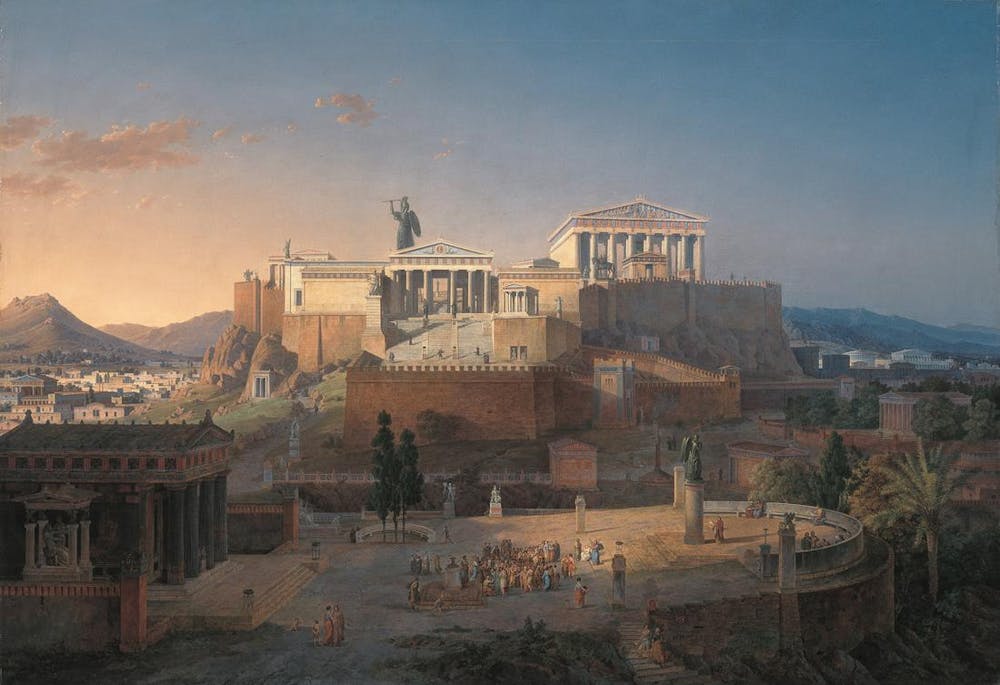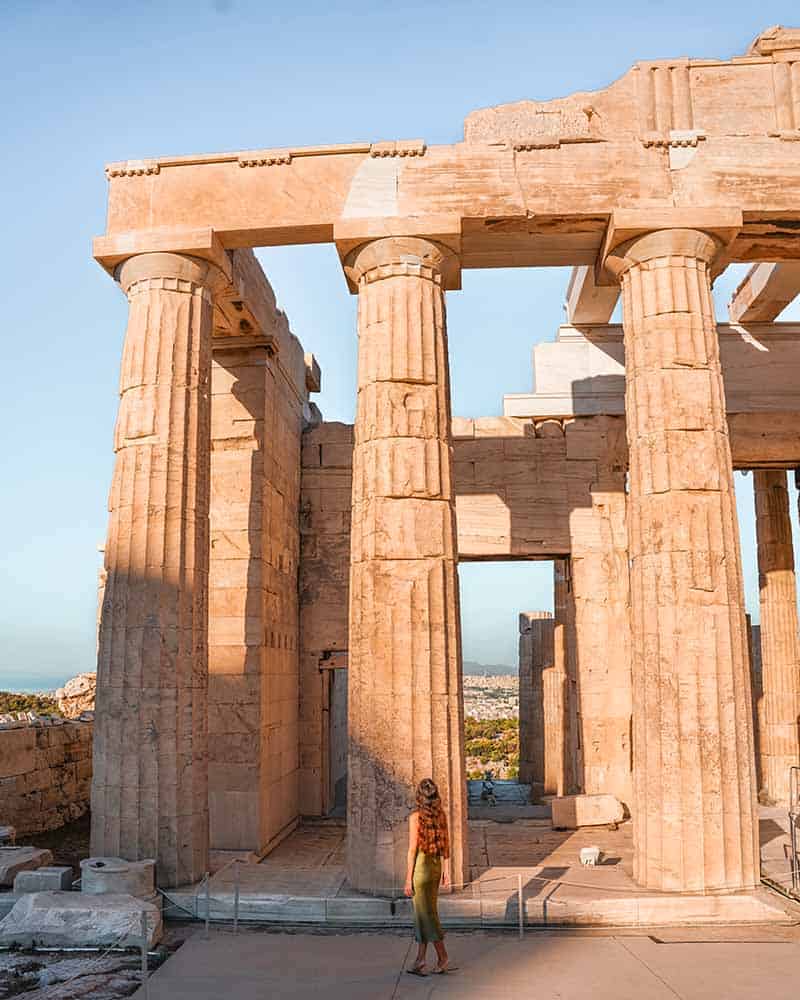Cradle of Civilization: Dive into Ancient Athens

Athens is a must-visit destination if you're planning a trip to Greece. It's a city with a rich history and culture that dates back to ancient times. Athens played an important role in the development of Western civilization and is often referred to as the Cradle of Civilization.
Overview of Athens's history and significance as the Cradle of Civilization
Athens is one of the oldest cities in the world, with a history that goes back more than 3,000 years. It was the birthplace of democracy, philosophy, and some of the greatest minds in history. Almost every corner of the city is a testament to its ancient past, with temples, statues, and buildings that have stood the test of time.
Some of the most notable landmarks in Athens include the Acropolis, the Parthenon, and the Agora. These historic sites offer a glimpse into the city's past and are must-visit destinations for anyone interested in history and culture.
Apart from its rich history, Athens also has a vibrant modern culture. Its streets are lined with restaurants, cafes, and bars where you can sample traditional Greek cuisine and enjoy the local vibe. And if you are a fan of shopping, there are plenty of boutiques, markets, and malls to explore.
Athens is a city with a fascinating blend of old and new. Its significance as the Cradle of Civilization makes it a must-visit destination for anyone interested in history and culture. Athens will leave a lasting impression if you're a first-time visitor or a seasoned traveller.
.jpg)
Acropolis
History and architecture of the Acropolis
If you're visiting Athens, the Acropolis is a must-visit destination. It's a historic hill that stands high above the city and is home to some of the most famous landmarks in Greece. The Acropolis has a rich history that dates back more than 2,500 years. It was once the centre of political and cultural life in ancient Athens, and its architecture reflects the city's golden age.
The Acropolis is characterized by its impressive marble temples and monuments. It was built during the 5th century BCE and today still stands as a testament to ancient Greek engineering and architecture. The structures on the Acropolis were constructed using some of the finest materials in Greece, with intricate details and carvings that are truly remarkable to behold.
Famous monuments and temples on the Acropolis
Some of the most famous landmarks on the Acropolis include the Parthenon, the Propylaea, the Erechtheion, and the Temple of Athena Nike. Each of these temples and monuments was built as a tribute to the gods and goddesses of ancient Greece.
The Parthenon is perhaps the most recognizable monument on the Acropolis. It was built in honour of the goddess Athena, and its stunning columns and intricate carvings are awe-inspiring. The Propylaea, which served as the entrance to the Acropolis, is also an impressive structure that features majestic columns and intricate details.
The Acropolis is a must-visit destination for anyone travelling to Athens. Its historical significance, remarkable architecture, and famous monuments make it a truly unique and unforgettable site to explore.

Parthenon
The history and architecture of the Parthenon
The Parthenon, located on the Acropolis Hill in Athens, is one of the most iconic landmarks in Greece. It was built in the 5th century BCE in honour of the goddess Athena, the patron goddess of Athens. The structure was designed by architects Ictinus and Callicrates and commissioned by Athenian statesman Pericles.
The Parthenon's architecture is a perfect example of ancient Greek excellence. It's a massive temple made of white marble with Doric columns. The temple also features a carved frieze that depicts scenes from the Panathenaic festival, which was held in honour of Athena. A complex system of pillars supports the entire structure, and beams are perfectly engineered to withstand the test of time.
The significance of the Parthenon in Athenian history and culture
The Parthenon was not just a monument; it held deep cultural significance for the Athenians. The temple's beauty and grandeur highlighted the power and dominance of Athens at the time. It served as a symbol of the city's wealth, and it was believed that Athena's presence in the temple protected Athens from harm. The Parthenon also housed a massive gold and ivory statue of Athena, which was considered one of the most significant works of art in ancient Greece.
The Parthenon's architecture, design, and cultural significance are why it remains a critical site for anyone visiting Athens. Standing in front of the Parthenon's towering pillars, you can't help but feel the weight and importance of history.
Ancient Agora
The history and importance of the Ancient Agora
The Ancient Agora is one of Athens, Greece's most important historical sites. It was the city's political, social, and economic centre. The Agora dates back to the 6th century BCE and was used as a public gathering place for Athenians. It was a place where people could meet, discuss political matters, and trade goods and services. The Agora played a crucial role in Athenian democracy, serving as the location for the assembly and the court of law.
Famous structures and buildings within the Agora
One of the most famous structures within the Agora is the Temple of Hephaestus. It was built in the 5th century BCE and is one of the best-preserved ancient Greek temples. The Temple of Hephaestus was dedicated to the god of blacksmiths and craftsmanship.
Another notable building within the Agora is the Stoa of Attalos. It was originally built in the 2nd century BCE and served as a shopping centre. It was reconstructed in the 1950s by the American School of Classical Studies and now serves as a museum.
The Agora also contains the Odeon of Agrippa, a small theatre used for musical performances; the Tholos, a circular building serving as a dining hall; and the Bouleuterion, where the council of 500 met to discuss political matters.
In conclusion, the Ancient Agora is an essential site for anyone visiting Athens as it allows visitors to immerse themselves in Athens' rich history and culture. The Agora serves as a reminder of Athens' significance in ancient Greece, having played a critical role in the formation and development of Athenian democracy.

The Plaka District
The history and culture of the Plaka District
The Plaka District is one of Athens' oldest and most picturesque neighbourhoods, known for its labyrinthine streets, ancient ruins, and stunning views of the Acropolis. It is believed that the district was inhabited continuously for over 3,000 years and has served as a hub of commercial and cultural activity throughout Athens' history. The district's charming architecture reflects various periods of Athenian history, including Roman, Byzantine, and Ottoman influences. Today, the Plaka District is a popular tourist destination, attracting visitors from all over the world who want to experience a taste of Greek culture in the heart of Athens.
Interesting landmarks and activities to do in the Plaka District
The Plaka District has several landmarks and attractions that showcase the area's culture and history. Visitors can explore the streets of Anafiotika, a tiny neighbourhood with charming white-washed homes, narrow streets, and brightly coloured flowers. Additionally, tourists can visit the recently renovated Museum of Greek Folk Art, which exhibits traditional Greek clothing, handicrafts, and other artefacts.
Tourists can also head to the Ancient Agora, which is located nearby and is a must-visit site. It contains several ancient structures, including the Temple of Hephaestus and the Stoa of Attalos. The district's streets also have taverns, cafes, and restaurants offering local cuisine and traditional souvenirs.
The Plaka District is a charming and captivating area worth exploring while visiting Athens. With its ancient ruins and unique culture, tourists glimpse Athens' rich history. The district offers various landmarks and activities that attract visitors from all around the world.

The Museum of the Acropolis
Overview of the Museum of the Acropolis
The Museum of the Acropolis is located near the entrance of the Acropolis and is one of the most popular attractions of Athens. The museum opened in 2009 to showcase the history and significance of the Acropolis. The building is home to some of Greece's most important archaeological finds, including ancient artefacts from the Greek Bronze Age to the Roman period.
The museum has three levels and offers an open-plan space with stunning views of the Acropolis. The ground floor introduces visitors to the museum with an introductory film, while the first level walks guests through the excavations of the Acropolis. The second level displays ancient artefacts, while the third level presents sculptures from the Parthenon frieze.
Famous artefacts displayed in the museum
The Museum of the Acropolis is home to several ancient Greek artefacts, including some of the most important sculptures from the Parthenon. The museum houses significant artefacts like the Caryatids, which are sculpted female figures that stand as columns on the Erechtheion temple. Visitors can also see the Pediments from the Parthenon, which are considered masterpieces of ancient Greek art.
Moreover, the museum showcases several artefacts from the Archaic and Roman periods. Visitors can view ancient objects like clay figurines, bronze vessels, glass vessels, coins, and weaponry.
The Museum of the Acropolis is a fascinating museum that displays significant ancient artefacts and offers visitors an in-depth look at the history of Athens. The museum allows visitors to learn more about Greek culture and history and is a must-visit site when exploring Athens.

National Archaeological Museum
History and significance of the National Archaeological Museum
The National Archaeological Museum of Athens is one of Greece's oldest and most important museums. It was founded in 1829 and moved to its current location in 1889. Since then, the museum has become the largest archaeological museum in Greece, with over 11,000 exhibits covering more than 5,000 years. The collections include objects from the prehistoric period, the Bronze Age, the Mycenaean period, and the Classical and Roman periods.
The museum is located in the centre of Athens and is housed in a neoclassical building designed by the architect L. Lange. The building is a work of art and contains beautiful sculptures, mosaics, and frescoes that are integral to the museum's collections.
Notable artefacts and collections showcased within the museum
The National Archaeological Museum is home to many collections, some of which are considered among the most significant in the world. One of the most famous collections is the Mycenaean collection, which includes objects made from bronze, gold, ivory, pottery, and jewellery. The museum is also home to the world's largest collection of ancient Greek pottery, with over 20,000 pieces.
Other notable collections within the museum include statues from the Archaic and Classical periods, including the bronze statue of Poseidon from Artemision and the exquisite marble statue of the Jockey of Artemision. Visitors can also see artefacts from ancient Athens, including items from the Acropolis and the Agora.
The National Archaeological Museum is a must-see attraction for anyone interested in ancient Greek history and art. The museum contains a vast collection of significant artefacts that provide a glimpse into the past and offer visitors an opportunity to appreciate the rich cultural heritage of Greece.

Day Trips from Athens
Interesting historical locations and natural wonders near Athens
If you're in Athens and looking to explore beyond the city limits, plenty of day trip options are available. A few notable locations to consider include:
-
The Sanctuary of Artemis at Brauron: This sanctuary dates back to the 6th century BCE and was once a significant centre for worship and festivals. Today, visitors can explore the site's ruins and see the impressive outdoor theatre.
-
The Temple of Poseidon at Sounion: This ancient temple dedicated to the Greek god of the sea is perched on a cliff overlooking the Aegean Sea. Visitors can take in the stunning views and learn about the temple's history at the on-site museum.
-
Meteora: This UNESCO World Heritage site is a few hours' drive from Athens but worth the journey. The site is home to many monasteries built atop towering rock formations, offering historical and natural wonders to explore.
Suggested day trip itineraries
If you're short on time and looking for a pre-planned day trip option, consider one of these itineraries:
-
Delphi day trip: This guided tour takes you to the ancient city of Delphi, which was once considered the centre of the world by the ancient Greeks. Highlights of the tour include visiting the Temple of Apollo, exploring the Delphi Archaeological Museum, and taking in the stunning mountain views along the way.
-
Saronic Gulf island hopping: This tour takes you on a ferry ride to three Saronic Gulf islands: Hydra, Poros, and Aegina. Highlights of the tour include exploring Hydra's picturesque port, visiting Poros's clock tower and archaeological museum, and sampling Aegina's famous pistachios.
No matter your day trip option, you'll surely come away with a deeper appreciation for Greece's rich history and natural beauty.

Wrap-up of the Ancient Athens Experience
From historic sites like the Acropolis and the Parthenon to ancient Agora and the Temple of Olympian Zeus, Athens offers many opportunities to explore the ancient past of Greece and its significance in Western civilization. Transport yourself back in time and marvel at ancient architectural wonders that seem frozen.
Recommendation for the must-see sights and experiences
To make the most of your visit to Athens, be sure to check out the following sights and experiences:
-
The Acropolis: No visit to Athens is complete without visiting the iconic Acropolis, a UNESCO World Heritage site and the most significant ancient monument in Western civilization.
-
The National Archaeological Museum: Greece's largest archaeological museum has a vast collection of ancient artefacts from across Greece dating back to prehistory.
-
The Plaka: Athens' oldest and most picturesque neighbourhood, located at the foot of the Acropolis. It features an array of shops, restaurants, and tavernas.
Your trip to Athens will be an unforgettable experience full of wonder and appreciation for the roots of Western civilization.
